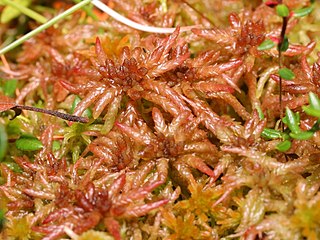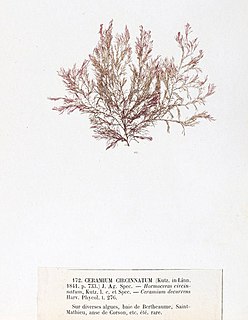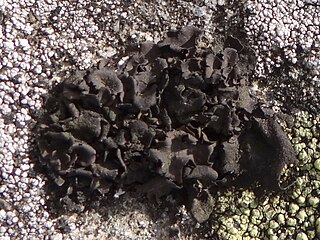
Evernia prunastri, also known as oakmoss, is a species of lichen. It can be found in many mountainous temperate forests throughout the Northern Hemisphere, including parts of France, Portugal, Spain, North America, and much of Central Europe. Oakmoss grows primarily on the trunk and branches of oak trees, but is also commonly found on the bark of other deciduous trees and conifers such as fir and pine. The thalli of oakmoss are short and bushy, and grow together on bark to form large clumps. Oakmoss thallus is flat and strap-like. They are also highly branched, resembling the form of deer antlers. The colour of oakmoss ranges from green to a greenish-white when dry, and dark olive-green to yellow-green when wet. The texture of the thalli is rough when dry and rubbery when wet. It is used extensively in modern perfumery.

Umbilicaria vellea is a species of lichen in the genus Umbilicaria. It is sometimes called navel lichen. It is found in North America and Europe in alpine and arctic habitats. It is similar to the species Umbilicaria americana, which has a more southern distribution.

Sphagnum magellanicum, commonly called Magellanic bogmoss, Magellan's sphagnum, Magellan's peatmoss or midway peat moss, is a widespread species of moss found in wet boreal forest in the far south and southwest of South America, North America and Eurasia.

Erythrotrichia is a red algae genus in the family Erythrotrichiaceae. In Iceland, E. carnea is red listed as a vulnerable species (VU).
Tayloria acuminata, commonly known as acuminate dung moss and acuminate trumpet moss, is a bright-green dung moss species with violet radicles that age to a dark red. It is native to North America and Iceland, where it is found in bird cliffs in Hornstrandir. In Iceland it has the conservation status of a vulnerable species (VU).
Phaeosaccion is a genus of algae with monostromatic tubular to saccate thalli, up to 20 centimetres (7.9 in) long and to 2 centimetres (0.79 in) wide. It is the sole genus in the family Phaeosaccionaceae. It is olive brown and resembles young plants of Scytosiphon. The sole species in the genus is Phaeosaccion collinsii, a species of marine algae. It was first identified in a publication by W.G. Farlow in the article Notes on New England algae published in Bulletin of the Torrey Botanical Club in 1882. It was named in honor of Frank Shipley Collins. Phaeosacchion collinsii is red listed in Iceland as a vulnerable species (VU).

Pseudocyphellaria crocata is a species of lichen in the family Lobariaceae of the ascomycetes.

Ceramium shuttleworthianum is a small marine red alga.

Ceramium circinatum is a small marine red algae.

Prasiola crispa is a small green marine or terrestrial seaweed.
Battersia arctica is a species of algae belonging to the family Sphacelariaceae. In Iceland, it is listed as a critically endangered species (CR).

Vulpicida pinastri is a species of foliose lichen in the family Parmeliaceae. The lichen has a greenish-yellow thallus and dorsiventral lobes. It grows on conifers and Betula in North America and Eurasia. It is the only sorediate species in the genus and is distinguished by the bright-yellow marginal soralia. The lichen, originally described by Italian naturalist Giovanni Antonio Scopoli in 1772, was transferred to the newly circumscribed genus Vulpicida by Jan-Eric Mattson and Ming-Jou Lai in 1993.
Gyroweisia tenuis is a species of moss belonging to the family Pottiaceae.
Neckera is a genus of moss belonging to the family Neckeraceae.

Umbilicaria polyphylla, commonly known as petaled rock tripe, is a widely distributed species of saxicolous lichen in the family Umbilicariaceae. It was first described by Carl Linnaeus in his 1753 work Species Plantarum as Lichen polyphyllus. German botanist Johann Christian Gottlob Baumgarten transferred it to the genus Umbilicaria in 1790. The lichen has a dark brown to black thallus that measures 2–6 cm (0.8–2.4 in) in diameter. The upper surface is smooth, while the lower surface is sooty black. It grows on exposed rocks, typically in arctic-alpine habitats.
Stereocaulon paschale is a species of fungus belonging to the family Stereocaulaceae.
Bryoria implexa is a species of horsehair lichen in the family Parmeliaceae.

Cladonia macilenta is a species of lichen in the genus Cladonia.

Cladonia strepsilis is a species of lichen in the genus Cladonia. In Iceland, where it is only found in a few locations in the Eastern Region, it is red listed as endangered (EN).
Struthiopteris fallax is a small species of fern in the family Blechnaceae. It is endemic to Iceland where it lives in close proximity to hot springs.











